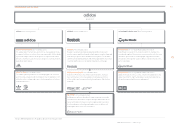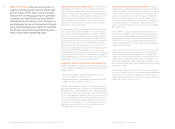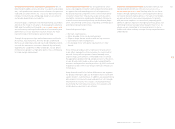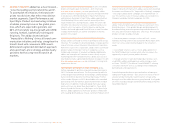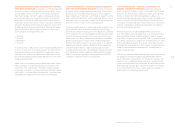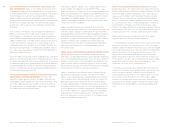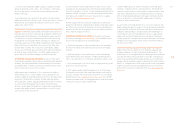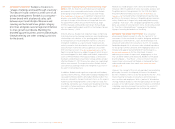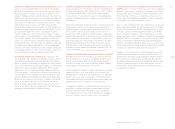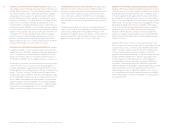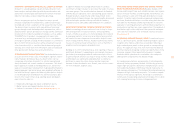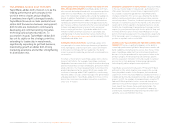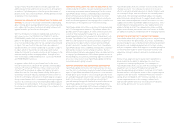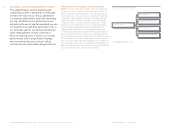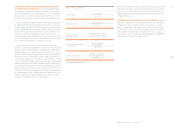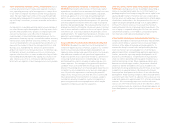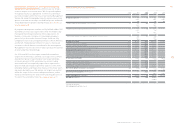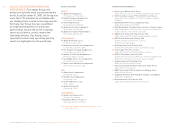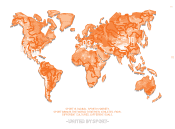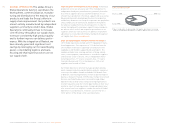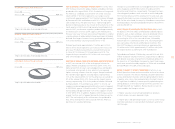Reebok 2007 Annual Report Download - page 57
Download and view the complete annual report
Please find page 57 of the 2007 Reebok annual report below. You can navigate through the pages in the report by either clicking on the pages listed below, or by using the keyword search tool below to find specific information within the annual report.053
ANNUAL REPORT 2007 --- adidas Group
02
ROCKPORT: EXPANDING IN THE CASUAL LIFESTYLE MARKET
Rockport is a leading global, lifestyle footwear brand. It com-
bines modern and stylish design with advanced comfort and
performance technologies derived from the athletic footwear
industry to provide a unique competitive advantage.
From a category perspective, Rockport has major growth
initiatives targeted at the urban/metro, outdoor, technology-
oriented and women’s segments of the casual lifestyle market.
The brand strives to connect with many different consumer
groups through a well-defi ned product segmentation, a disci-
plined channel-specifi c distribution strategy and the continued
incorporation of industry-leading technologies such as adidas
TORSION® into its product. Leveraging the Group’s infra-
structure (e. g. in emerging markets) is also a core element
in Rockport’s growth strategy. The brand expects to continue to
grow its North American business while achieving increased
sales internationally (i. e. outside of North America) going for-
ward. By 2010, more than 50 % of Rockport sales are expected
to be generated in Europe, Asia and Latin America.
OPTIMIZING EXISTING DISTRIBUTION The wholesale business
accounts for 84 % of total sales in the Reebok segment. Histor-
ically, Reebok’s distribution base has been rather narrow,
comprising only certain channels (i. e. athletic specialty and
family footwear) and a small number of customers. This distri-
bution approach created an overdependence on, and an over-
exposure to, particular retail partners. Subsequently, Reebok’s
bargaining power and brand image were negatively affected. In
line with the Group’s approach to diversify distribution, Reebok
is now broadening its distribution mix and increasing its pres-
ence in other retail formats (e. g. sporting goods and depart-
ment stores) in order to:
- Improve brand image and regain credibility in sports,
- Better service existing distribution channels, and
- Reduce its customer risk. see Risk and Opportunity Report, p. 104
In addition, Reebok increasingly differentiates its product
assortment amongst retailers to best meet the needs of various
consumer groups. The core distribution channels for Reebok-
CCM Hockey are specialist stores and sporting goods retailers.
Rockport products are primarily sold in department stores
and the family footwear channel. By segmenting the brand and
differentiating the product offering available for retailers,
Rockport ensures a broad-based distribution of its products.
GROWTH OPPORTUNITIES THROUGH CONTROLLED SPACE
Reebok increasingly focuses on the roll-out of shop-in-shops
with retail partners in mature markets, while expanding
its own-store base as well as its mono-branded store network
in emerging markets. In the near-term future, factory outlets
will remain the most important format within Reebok’s own-
retail strategy in North America. Reebok-CCM Hockey mainly
focuses on working closely with partners such as the NHL to
establish jointly managed co-branded stores.
Building on its 2007 momentum (e. g. store openings in Russia
and China), Rockport is expanding its own concept store base
(particularly in emerging markets) and increasing its efforts
in partnering with retailers via shop-in-shops. Further, Reebok
and Rockport are signifi cantly extending their e-commerce
platforms to make the online channel another important
element of their distribution mix. Overall, own retail accounts
for 16 % of Reebok segment sales.
IMPROVING BRAND MANAGEMENT AND GAINING MARKET
SHARE VIA DISTRIBUTOR BUYOUTS Reebok, Reebok-CCM
Hockey and Rockport have each established own sales organi-
zations in major markets around the globe. Nevertheless, all
three continue to work with third-party distributors in many
markets. To better control brand management and gain mar-
ket share, Reebok and Rockport continue to buy back distribu-
tion rights for the Reebok and Rockport brands or wait until
expiration of existing agreements with distribution partners to
eventually set up their own sales organizations. The buyback of
distribution rights offers additional sales potential and repre-
sents the most important area of Reebok revenue synergies.
see Outlook, p. 118
INCREASING AVERAGE SELLING PRICES To reinforce its posi-
tion as a premium sports and lifestyle brand, Reebok’s goal is
to signifi cantly improve and increase its product offering at
high- and mid-price points to drive growth in average selling
prices. This approach may slow short-term top-line develop-
ment by voluntarily foregoing commercial opportunities in the
low-price segment. More importantly, however, it enables
Reebok to build a platform for sustainable sales and profi t-
ability growth and preserves the brand’s image.
As a leading manufacturer and marketer of technologically-
advanced hockey equipment, Reebok-CCM Hockey primarily
targets high-price points. By further strengthening its innova-
tion leadership, Reebok-CCM Hockey intends to preserve its
high average selling prices. The Rockport brand predominately
competes at high- and mid-price points. To increase competi-
tiveness in these price segments, the brand is committed to
continuously incorporating advanced technologies into its prod-
ucts, making technology its main selling proposition.


